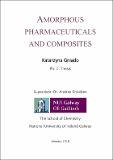| dc.description.abstract | An attractive, yet challenging approach to overcome poor water solubility is to convert a crystalline Active Pharmaceutical Ingredient (API) into its more soluble amorphous form.1-3 Nevertheless, the use of amorphous drug compounds is restricted due to their inherently poor physical stability and tendency to re-crystallization during manufacturing, storage, or dissolution.3-5 Currently, the most commonly used method to stabilize the amorphous state is the formulation as a solid polymer dispersion.6 Unfortunately, this method does not guarantee long-term stability and is associated with difficulties in manufacturing and processing. Recently, the formation of co-amorphous stoichiometric mixtures consisting of two active drug substances or a drug and a small-molecule excipient by milling has emerged as an alternative approach.7-10
Milling is a secondary process in the manufacturing of the pharmaceuticals, typically used to reduce the particle size, and often associated with a degree of amorphisation.11, 12 Studies of the effect of excipient on the API milling were carried out and found that API-excipient interactions may promote or suppress amorphisation during milling. Interestingly, co-milling of stoichiometric mixtures with small-molecule excipients can produce composite amorphous systems or co-crystals.13, 14
Regrettably, the factors that determine whether a co-amorphous system or a co-crystal is formed are poorly understood.
To enable a better understanding, amorphisation of Sulfamerazine with a number of small multifunctional polycarboxylic acids was carried out. Co-amorphous systems of Sulfamerazine/citric acid, Sulfamerazine/deoxycholic acid and Sulfamerazine/sodium taurocholate (NaTC) were prepared and investigated using X-ray powder diffractometry and spectroscopic analysis. Stability studies revealed Sulfamerazine/NaTC provided both superb stability towards re-crystallisation and enhanced dissolution behaviour.
Accordingly, further studies of NaTC co-milled with 18 APIs were carried out to reveal striking properties of three key systems: Carbamazepine/NaTC, Indomethacin/NaTC and Mefenamic acid/NaTC. The dissolution properties were found to improve significantly in all three systems, though the most remarkable enhancement was observed for Mefenamic acid/NaTC, which dissolved instantly, as opposed to practically insoluble crystalline Mefenamic acid. The stability of these systems was monitored at ambient conditions and was found to exceed 11 months in the case of Carbamazepine/NaTC and Indomethacin/NaTC. Spectroscopic analysis was carried out to reveal the type of interactions between the APIs and NaTC: no evidence of intricate interactions were found, other than intimate mixing in Carbamazepine/NaTC and Indomethacin/NaTC systems.
Co-milling of Carbamazepine with a number of small multifunctional polycarboxylic acids resulted in formation of various co-crystals and several co-amorphous systems. This led to a more comprehensive screening study concerning several other structurally diverse APIs. It seems that it is probably a combination of different factors, rather than a single factor, that determines whether a co-amorphous system or a co-crystal forms, making the development of a predictive model difficult. Sodium taurocholate was the only co-former consistently producing co-amorphous systems with APIs. | en_IE |
| dc.local.note | Currently a vast number of pharmaceuticals produced suffers poor solubility, often requiring large doses of the drug to be administered, which can also lead to unwanted side effects and overall performance issues. A way to overcome this is to produce crystalline drugs in their disordered, amorphous, state, which often shows increased solubility and therefore enhanced performance. | en_IE |


